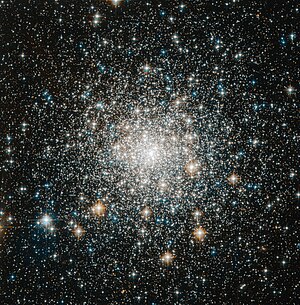astro.wikisort.org - Galaxy
Messier 70 or M70, also known as NGC 6681, is a globular cluster of stars to be found in the south of Sagittarius.[lower-alpha 1] It was discovered by Charles Messier in 1780.[lower-alpha 2][6] The famous comet Hale–Bopp was discovered near this cluster in 1995.[10][lower-alpha 3]
| Messier 70 | |
|---|---|
 Globular cluster Messier 70 by Hubble Space Telescope; 3.3′ view | |
| Observation data (J2000 epoch) | |
| Class | V[1] |
| Constellation | Sagittarius |
| Right ascension | 18h 43m 12.76s[2] |
| Declination | –32° 17′ 31.6″[3] |
| Distance | 29.4 kly (9.0 kpc)[4] |
| Apparent magnitude (V) | 7.9[5] |
| Apparent dimensions (V) | 8.0′[6] |
| Physical characteristics | |
| Mass | 1.79×105[4] M☉ |
| Radius | 34 ly[7] |
| Tidal radius | 11.2′[8] |
| Metallicity | = –1.35[9] dex |
| Estimated age | 12.80 Gyr[9] |
| Other designations | GCl 101, M70, NGC 6681[3] |
It is about 29,400[4] light years away from Earth and around 6,500 light-years[11] from the Galactic Center. It is roughly the same size and luminosity as its neighbour in space, M69.[12] M70 has a very small core radius of 0.22 ly (0.068 pc)[13] and a half-light radius of 182.0 ly (55.80 pc).[14] This cluster has undergone core collapse, leaving it centrally concentrated[15] with the luminosity distribution following a power law.[11]
There are two distinct stellar populations in the cluster, with each displaying unique abundance abundances. These likely represent different generations of stars.[16] Five known variable stars lie within the broadest radius, the tidal radius, of it, all of which are RR Lyrae variables.[8][17] The cluster may have two blue stragglers near the core.[11]
Gallery
- Image by Hubble Space Telescope.
 Map showing M70, against a conventional (southern) horizon
Map showing M70, against a conventional (southern) horizon
See also
- List of Messier objects
References and footnotes
- Shapley, Harlow; Sawyer, Helen B. (August 1927), "A Classification of Globular Clusters", Harvard College Observatory Bulletin, 849 (849): 11–14, Bibcode:1927BHarO.849...11S.
- Goldsbury, Ryan; et al. (December 2010), "The ACS Survey of Galactic Globular Clusters. X. New Determinations of Centers for 65 Clusters", The Astronomical Journal, 140 (6): 1830–1837, arXiv:1008.2755, Bibcode:2010AJ....140.1830G, doi:10.1088/0004-6256/140/6/1830.
- "NGC 6681". SIMBAD. Centre de données astronomiques de Strasbourg. Retrieved 17 November 2006.
- Boyles, J.; et al. (November 2011), "Young Radio Pulsars in Galactic Globular Clusters", The Astrophysical Journal, 742 (1): 51, arXiv:1108.4402, Bibcode:2011ApJ...742...51B, doi:10.1088/0004-637X/742/1/51.
- "Messier 70". SEDS Messier Catalog. Retrieved 30 April 2022.
- Adam, Len (2018), Imaging the Messier Objects Remotely from Your Laptop, The Patrick Moore Practical Astronomy Series, Springer, p. 304, Bibcode:2018imor.book.....A, ISBN 978-3319653853
- distance × sin( diameter_angle / 2 ) = 34 ly. radius
- Liller, M. H. (October 1983), "The variable stars in the field of the globular cluster NGC 6681", Astronomical Journal, 88: 1463–1469, Bibcode:1983AJ.....88.1463L, doi:10.1086/113435.
- Forbes, Duncan A.; Bridges, Terry (May 2010), "Accreted versus in situ Milky Way globular clusters", Monthly Notices of the Royal Astronomical Society, 404 (3): 1203–1214, arXiv:1001.4289, Bibcode:2010MNRAS.404.1203F, doi:10.1111/j.1365-2966.2010.16373.x.
- Mobberley, Martin (2013), It Came From Outer Space Wearing an RAF Blazer!: A Fan's Biography of Sir Patrick Moore, Springer Science & Business Media, p. 483, ISBN 978-3319006093
- Watson, Alan M.; et al. (November 1994), "Far-ultraviolet imaging of the globular cluster NGC 6681 with WFPC2" (PDF), Astrophysical Journal, Part 2, 435 (1): L55–L58, Bibcode:1994ApJ...435L..55W, doi:10.1086/187593.
- Frommert, Hartmut; Kronberg, Christine (30 August 2007), "Globular Cluster M70", SEDS Messier pages, Students for the Exploration and Development of Space (SEDS), retrieved 4 December 2018.
- Djorgovski, S. (January 1993), "Physical Parameters of Galactic Globular Clusters", in Djorgovski, S. G.; Meylan, G. (eds.), Structure and Dynamics of Globular Clusters. Proceedings of a Workshop held in Berkeley, California, July 15–17, 1992, to Honor the 65th Birthday of Ivan King, vol. 50, San Francisco, California: Astronomical Society of the Pacific, p. 373, Bibcode:1993ASPC...50..373D, ISBN 978-0937707692.
- Forbes, Duncan A.; et al. (October 2008), "Uniting old stellar systems: from globular clusters to giant ellipticals", Monthly Notices of the Royal Astronomical Society, 389 (4): 1924–1936, arXiv:0806.1090, Bibcode:2008MNRAS.389.1924F, doi:10.1111/j.1365-2966.2008.13739.x.
- Pryor, Carlton; et al. (August 1989), "Mass-to-light ratios for globular clusters. I - The centrally concentrated clusters NGC 6624, M28 (NGC 6626), and M70 (NGC 6681)", Astronomical Journal, 98: 596–610, Bibcode:1989AJ.....98..596P, doi:10.1086/115160.
- O'Malley, Erin M.; et al. (September 2017), "High-resolution Spectroscopic Abundances of Red Giant Branch Stars in NGC 6681", The Astrophysical Journal, 846 (1): 15, arXiv:1706.06962, Bibcode:2017ApJ...846...23O, doi:10.3847/1538-4357/aa7b72, 23.
- Clement, Christine M.; et al. (November 2001), "Variable Stars in Galactic Globular Clusters", The Astronomical Journal, 122 (5): 2587–2599, arXiv:astro-ph/0108024, Bibcode:2001AJ....122.2587C, doi:10.1086/323719.
- On the southernmost line of the main (teapot) asterism; its declination means it will not rise (above the horizon) above the 58th parallel north and will need the observer to be as much as a further fifteen degrees of latitude south for detailed, little distorted observation
- on 31 August
- on 23 July
External links
- Messier 70, Galactic Globular Clusters Database page
- Messier 70 on WikiSky: DSS2, SDSS, GALEX, IRAS, Hydrogen α, X-Ray, Astrophoto, Sky Map, Articles and images
На других языках
[de] Messier 70
Messier 70 (auch als NGC 6681 bezeichnet) ist ein 9,06 mag heller Kugelsternhaufen mit einer Flächenausdehnung von 7,8' im Sternbild Schütze. M70 ist in Mitteleuropa wegen seiner südlichen Position nicht leicht zu beobachten.- [en] Messier 70
[ru] M 70 (звёздное скопление)
M 70 (также известное, как Мессье 70 или NGC 6681) — шаровое звёздное скопление в созвездии Стрельца.Другой контент может иметь иную лицензию. Перед использованием материалов сайта WikiSort.org внимательно изучите правила лицензирования конкретных элементов наполнения сайта.
WikiSort.org - проект по пересортировке и дополнению контента Википедии



